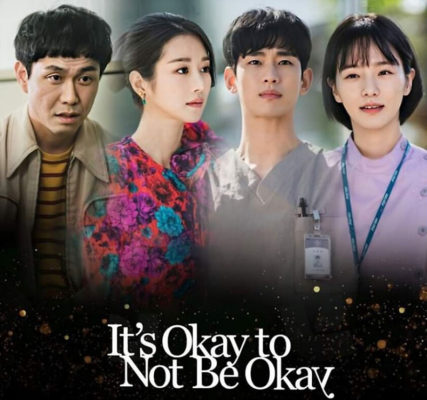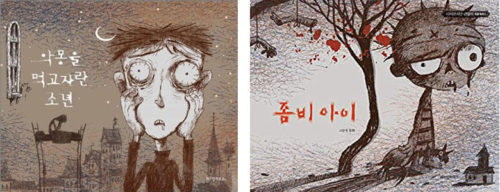K-drama review: It’s Okay to Not Be Okay

Sometimes I need an engrossing, hyper-real, overwrought drama with plenty of romance and a little comedy, and only a K-drama will hit the spot. The previous few I watched hadn’t quite worked for me, but It’s Okay to Not Be Okay (tvN/Netflix, 2020) was just right. It’s far from a perfect show but it is very entertaining in its heightened mishmash of styles.
Our lead character is Moon Gang-tae (Kim Soo-hyun), who works as a caretaker in psychiatric wards/hospitals and lives with his brother Moon Sang-tae (Oh Jung-se, from When the Camellia Blooms) who has autism and works various low-paid jobs. They move homes and jobs frequently, which is related to Sang-tae having witnessed their mother’s murder when they were young.
Gang-tae is both sweet and very capable, but to cope with the difficulties of caring for his brother and their frequent moves, he can come across as cold and unemotional. This makes him an ideal sparring partner for Ko Moon-young (Seo Yea-ji), a popular children’s author who is brittle and quick to anger.
After shocking her fans with an angry outburst at a book signing, Moon-young decides to hide from the public eye by moving back to her childhood home – a spooky mock castle in the woods in Seongjin City. She lives there alone, as her mother went missing when she was young and her father is a patient in the local OK Psychiatric Hospital. It has the added benefit of being where Gang-tae has most recently moved with his brother, Moon-young having developed an obsession with him since they crossed paths in Seoul.
I quite like that the woman is the one who does the chasing in this romantic storyline, and that Moon-young is unashamedly sex-positive (there is a B-plot romance that is more traditional and is pretty sweet too). I also like that the romance is just one of several overlapping stories and only occasionally the main one. Moon-young is the most exaggerated character in a generally unsubtle show, but she is also super-rich living an isolated life with most of her contact with other people being fawning fans or even more fawning employees at her publishing house, so both her flamboyant fashion sense and her inflated ego are pretty believable. It helps that Seo is for me the most capable actor in the main cast (I found Kim pretty one-note – all puppy eyes).
Arguably the primary plot is the tangled mystery of Gang-tae’s mother’s murder and how it may or may not be linked to Moon-young’s dark and messy past. It is largely ridiculous and full of red herrings (there is, after all, a psychiatric hospital full of supporting characters with various levels of question marks about their past and motivations). Some twists are obvious and some come entirely out of the blue. But unearthing our lead characters’ pasts also serves to explain why they turned out the way they did.
Or perhaps the main plot is the relationship between the brothers Gang-tae and Sang-tae, and their gradual acceptance that it’s not only possible to adopt a found family later in life, but that it could make their lives happier and easier. It’s probably my favourite storyline, but then I am a sucker for found family stories.
Until now, the only other constant in their lives has been Gang-tae’s best friend Jo Jae-soo (Kang Ki-doong, who had a small role in Romance Is a Bonus Book) who has jeopardised his own career as a restaurateur by following the Moon brothers every time they move. There are definite hints that Jae-soo is in love with Gang-tae – this is never directly addressed but does result in some scenes that could be read as homophobic cliches (not least of which is that he’s presented as completely non-sexual). On the other hand, having a (even unacknowledged) gay character who’s not camp or negative in any way is so rare in K-dramas that I tend to see this as overall a positive.
There is of course an initial attempt at a love triangle, but it is so obvious which way the drama is going that it’s hard to take seriously. The other woman gets an unfortunate amount of screen time mooning lovelorn over Gang-tae, but she eventually gets a better plot.
The one thing I am not certain of is how I feel about the depiction of Sang-tae’s autism. While in some aspects it is (to the best of my knowledge) realistic, like everything else in the drama it is ramped up to 11 quite often. Sang-tae has no language impediments and can hold down a job, but he is mollycoddled by his brother and I couldn’t quite tell if that was supposed to be a comment on Gang-tae and his overblown sense of responsibility, or if it was the writers treating Sang-tae in an overly child-like way.
For the most part I think this series does a good job in its treatment of mental health and the kinds of problems that might land patients in a psychiatric hospital. A range of problems are depicted and though some patients do come under suspicion in the various mystery plot lines, they are all by the end depicted as fully rounded human beings needing temporary periods of in-patient care.

But the real standout aspect of this show, and the thing that really entranced me, is that five of Moon-young’s children’s books are featured. They are narrated in full with animated artwork reminiscent of Chris Riddell. The stories are heavily fairy-tale influenced, suitably weird and dark to be believable products of Moon-young. In fact, they are actual books written specially for this show by Jo Yong (who also wrote the whole show) and illustrated by Jam San. They were published in 2020 and are all bestsellers. I think they are only available in Korean and quite expensive to buy in the UK, so although at around 20 pages each this wouldn’t a bad way for me to brush up on the language, there are more easily available ways to learn Korean.